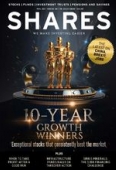Archived article
Please note that tax, investment, pension and ISA rules can change and the information and any views contained in this article may now be inaccurate.
The big decision: take profits or run your winners?

For many investors, the value of their portfolios and the share prices of the stocks within it will – if they choose correctly – rise gradually and steadily over time. Bouts of volatility are to be expected and there might be the occasional sharp drop or quick swing upwards after good or bad news.
But sometimes shares can soar. A company with a new innovation or a business brought back from the brink can suddenly surge beyond all expectation. At that point, investors are faced with a choice: pocket the profits or see how far the shares can go.
HOW QUICKLY SHOULD YOU CASH IN PROFITS?
Premium mixer drinks maker Fevertree (FEVR:AIM) is a recent example of a staggering success story. The company floated on the stock exchange in November 2014 at 134p and quickly gained a following from investors who thought the company had spotted a gap in the market, benefiting from the so-called ‘ginaissance’ and consumer shift to luxury tonics.
Investors would no doubt have been delighted to have doubled their money by April 2015. But if they had sold their shares then they would likely be kicking themselves by now: the shares have increased by 27-fold since they started trading, now priced at £36.15.
But would you have been brave enough to keep holding the shares while they climbed and climbed? When a share price soars, how do you know when it’s time to take those profits and when it’s got further to run?
RUN YOUR WINNERS IF THE INVESTMENT CASE STILL STACKS UP
Ben Peters, co-manager of investment fund Evenlode Income (BD0B7C4), says: ‘If a share price has doubled, so what? What is important is whether the company still fits my criteria for investing – if it does, we continue to hold the shares.’
Peters and his colleague Hugh Yarrow look for quality companies with high barriers to entry to stave off the competition and those which are not bogged down with lots of debt.
He invested in computer company Microsoft in 2012. At the time it was seen as a dinosaur compared with the likes of fast-growing tech firms such as Apple and Amazon.
Peters says: ‘But we saw some attractive qualities – it had a dominant market share and was sorting out its cloud computing business.’ Over the past two years the share price has doubled to more than $100.
THINKING ABOUT THE POTENTIAL UPSIDE AND DOWNSIDE
Alex Wright, fund manager of Fidelity Special Situations (B4566K2), says with all his investments, he thinks about how much it could potentially go up and how much it could potentially go down.
One of his most successful investments was luxury handbag maker Mulberry (MUL:AIM). He bought shares in 2009 in the middle of the financial crisis when there were widespread fears that consumers would stop spending on luxury items as well as worries about a slowdown in China.
Wright thought the issues were short-term and bought the shares at 65p. Two years later they had rocketed an incredible 2,000%. Had he held on a little longer, they finally peaked in mid-2012 at £24 a share.
He says: ‘As a contrarian investor I tend to sell early – when other people start to get interested in a stock, I start to worry.’
Simon Gergel, fund manager of Merchants Trust (MRCH), explains: ‘The key is to have a good idea of what a company is worth – but you have to constantly re-evaluate that.’
It’s not just individual stocks which can defy investor expectations either. Only last year the FTSE 100 broke the 7,500 mark for the first time – something which many investors never envisaged. The MSCI North America index, meanwhile, has returned more than 220% over the past decade.
BUYING WHEN PEOPLE ARE WORRIED… AND SELLING WHEN A STOCK RETURNS TO FAIR VALUE
One of Gergel’s recent successes is an investment in marketing group St. Ives (SIV) which had seen shares plunge after profit warnings. After a restructuring, which involved selling off several parts of the business, it said adjusted pre-tax profit was up 35% in its latest half year results. The share price has nearly doubled in the past year alone.
He also invested in cruise operator Carnival (CCL) six years ago, shortly after the tragic sinking of the Costa Concordia. A restructuring, cost-cutting and a lack of ship capacity benefiting prices in the industry eventually saw the share price climb 150%.
Typically, as a share price starts to get close to what Gergel calls ‘fair value’ he starts to sell it gradually rather than wait for it to hit a certain number and sell all at once. He says: ‘You have to be disciplined because the danger is that it gets expensive and the price falls again.’
Fund managers often use strict criteria to help them in these decisions as it helps them avoid making a decision driven by emotion. But Peters at Evenlode adds: ‘Our job is to identify high-quality companies and work out what their value is, regardless of what the share price does. But sometimes, when shares have appreciated rapidly, you do wonder whether it can continue.’ (HB)
Disclaimer: Editor Daniel Coatsworth has a personal investment
in Evenlode Income referenced in this article.
Important information:
These articles are provided by Shares magazine which is published by AJ Bell Media, a part of AJ Bell. Shares is not written by AJ Bell.
Shares is provided for your general information and use and is not a personal recommendation to invest. It is not intended to be relied upon by you in making or not making any investment decisions. The investments referred to in these articles will not be suitable for all investors. If in doubt please seek appropriate independent financial advice.
Investors acting on the information in these articles do so at their own risk and AJ Bell Media and its staff do not accept liability for losses suffered by investors as a result of their investment decisions.

 magazine
magazine














